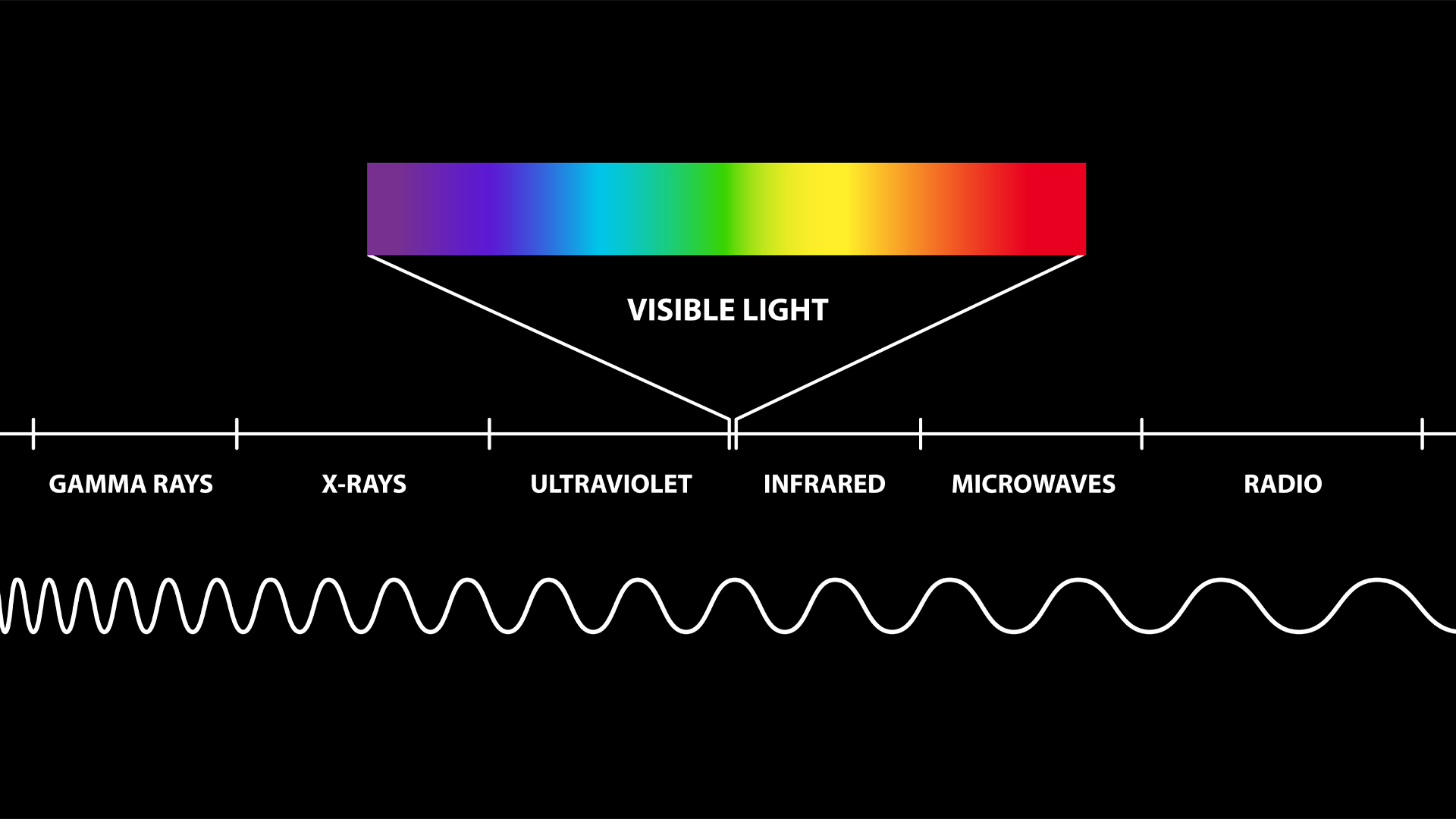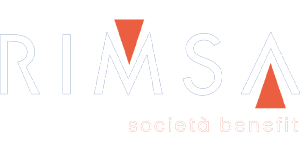Training by RIMSA
Light and Lighting Quality
Light: an essential element for life and work
1
What Is Light?
Light is a form of electromagnetic energy occupying a specific portion of the electromagnetic spectrum between infrared and ultraviolet radiation. Commonly, when we say “light,” we refer to the band perceptible by the human eye, enabling us to see the world around us.
Yet, light is much more than a mere physical phenomenon; it’s a constant source of inspiration, a vital force for life, and a discipline-spanning subject—from biology and art to engineering and architecture. A fundamental definition of light matters because it’s not just an electromagnetic wave. It can also be described in terms of photons, massless particles that carry energy. This wave-particle duality has captivated scientists and fueled pivotal theories like quantum mechanics. Beyond that, light profoundly touches everyday life. Without it, life on Earth would cease: photosynthesis—the process essential to many organisms—relies entirely on sunlight.

While it’s enough for many of us to know light lets us perceive colors and shapes, it’s intriguing to consider how deeply it shapes human existence. Natural daylight governs our biological clock, while artificial lighting extends our daily activities well beyond sunset. Whether natural or artificial, different light sources offer varying intensities and color tones, influencing our mood and productivity as much as they affect our visual perception.
From a broader perspective, light isn’t merely about physics or technology; it’s also a critical driver of social progress. Understanding what light is sets the stage for appreciating its far-reaching effects on health, mood, productivity, and general well-being. This introduction is meant to spark curiosity, paving the way for topics in subsequent sections, where we’ll explore why light matters to humanity, how it shapes work, how we gauge its quality, and the standards regulating workplace lighting.
2
Why Is Light Important for Humans?
Light plays a pivotal role in human life, with effects spanning biology, psychology, and social organization. First and foremost, sunlight is vital for vitamin D production—a key factor for bone health and a range of physiological functions.
Without sufficient sun exposure, the body struggles to generate this vitamin, elevating the risk of conditions like osteoporosis and immune disorders.
On the psychological front, light has a direct impact on mood and mental well-being. Scientific studies show that ample natural light helps regulate the circadian rhythm—the body’s internal clock that modulates sleep-wake cycles. Individuals who spend prolonged hours in dim environments or, conversely, face intense artificial lighting at night can experience sleep disruptions and imbalances in overall health. Seasonal Affective Disorder (SAD) is a well-known example: it can emerge during winter months when diminished daylight triggers depressive symptoms and low energy.
Culturally and socially, light has always been charged with symbolism. Religious and philosophical traditions often link light to knowledge, truth, or the divine. Historically, people equated light with intellectual or spiritual enlightenment. Even now, the idea of “bringing light” into a space or “casting light” on a new idea retains a positive connotation, manifesting in ongoing efforts to optimize lighting—at home, in public areas, and across communities.
Another vital aspect is safety: well-lit areas see fewer accidents and less criminal activity. Think of city streets or workplaces where inadequate lighting can raise the risk of both injuries and illicit behavior. This correlation between lighting and security drives designers, city planners, and businesses to invest in robust lighting solutions that not only ensure good visibility but also foster a sense of comfort and protection.
A final point worth highlighting is aesthetics. Light often doubles as a design tool to enhance indoor and outdoor settings, whether through directional spotlights, colored illumination, or accent lighting. Such techniques can transform a space, adding warmth, modern flair, or dramatic ambiance. In public urban areas, light installations and artistic projections can redefine entire plazas, monuments, or building facades, creating immersive experiences and unique visual spectacles.
Essentially, light profoundly influences human physiology, psychology, security, and even aesthetics. Managing and using it responsibly is thus integral to fostering overall well-being and quality of life, both at the individual and collective levels. In the following sections, we’ll explore how light impacts work specifically, how it’s evaluated, and what regulations guide its use in professional environments.
3
How Does Light Impact Human Work?
In work settings, light is indispensable—shaping both productivity and the well-being of employees. Research shows that effective lighting can sharpen focus, lessen visual fatigue, and improve overall comfort.
This applies not only to offices but also to industrial production lines, storage facilities, and any workspace where tasks demand accuracy and concentration. Light affects reading speed, the detection of flaws in manufacturing processes, and overall job performance.
An often-overlooked consideration is suitable lighting during night shifts or in locations with limited natural daylight. If workplaces rely on weak lighting or intense artificial light at night, circadian rhythms become disrupted. This can lead to sleep disturbances, chronic fatigue, and a noticeable decline in concentration. Consequently, a growing number of organizations are adopting dynamic lighting systems that mimic natural daylight rhythms, helping preserve a more balanced physical and mental state among workers.
Lighting also influences job safety. On construction sites, in industrial plants, or even conventional offices, subpar illumination raises the risk of accidents, injuries, and poor judgment calls. Walkways and operational zones that aren’t well lit increase the likelihood of tripping hazards, unseen obstacles, and procedural errors.

When companies invest in high-quality lighting systems, they reduce workplace accidents and production downtime—benefiting both personnel and the bottom line. The psychological component of lighting in the workplace matters, too. An inviting, well-illuminated atmosphere—possibly leveraging daylight from windows and skylights, complemented by intelligently designed artificial lighting—cultivates a more comfortable environment. Employees in poorly lit, dreary offices often report diminished motivation, heightened irritability, and lower overall satisfaction. By contrast, thoughtfully lit spaces help decrease stress and foster collaboration and open communication among team members.
Lastly, the choice of light sources can affect energy consumption and overall operational costs. Many companies now utilize LED installations and automated controls that adapt light levels to occupancy and available daylight. These strategies not only slash energy use but also offer a stable, pleasant brightness that boosts employee welfare and promotes a more eco-friendly brand image.
In sum, lighting is a decisive factor in workplace quality. Whether natural or artificial, smartly planned illumination exerts a significant impact on employees’ physical and mental health, safety, and work output. In upcoming sections, we’ll delve into how light can be evaluated for specific attributes and the standards governing optimal lighting across varied professional settings.
4
How Do We Qualify Light?
Thanks to modern research and technological leaps in the lighting industry, we can pinpoint three core parameters crucial for determining light quality: intensity, color fidelity, and color temperature. While these elements are often discussed separately, they cannot be viewed in a vacuum. Rather, each one depends on—and amplifies—the others, creating lighting experiences that can be comfortable, productive, or even therapeutic in certain contexts.
When we talk about “light quality,” there isn’t a single all-encompassing metric. Instead, multiple attributes define how well lighting meets visual and functional requirements in a given environment.
Light Intensity
Measured in lumens or lux (depending on the application), light intensity represents how much light is emitted or present in a space. Striking the right intensity is key to visibility and comfort. Yet more light isn’t automatically better; excessive brightness causes glare, eyestrain, and energy waste. To avoid this, lighting designers consider the specific needs of a space. For example, offices call for different lighting requirements than warehouses or retail display areas.
Discover more
Definition and Key Metrics
Light intensity refers to the amount of light emitted (or perceived) within a given space or direction. It can be expressed through several metrics, including:
– Luminous Flux (lumens, lm): The total luminous output from a source in all directions.
– Illuminance (lux, lx): The number of lumens falling on one square meter (1 lux = 1 lumen/m²). This metric is crucial in work and living spaces because it reflects how much “usable light” actually reaches a specific surface.
– Luminous Intensity (candela, cd): The luminous flux per unit solid angle, offering insight into the directional behavior of a light source.
Evolving Methods of Calculation
Historically, light intensity was measured using basic tools such as lux meters, which registered light hitting a photodiode. The proliferation of LEDs and other high-efficiency sources demanded more refined approaches, including laboratory photometric tests and software simulations. These techniques assess the photometric distribution, beam angles, and even the spectral characteristics of the source.Modern lighting design software (e.g., Dialux, Relux) allows designers to import photometric files (IES, LDT) provided by manufacturers, simulating how light will distribute within a space. This includes evaluating average illuminance, uniformity levels, and glare risk (UGR).
Critiques and Potential Improvements
– Purely Photometric vs. Human Perception: Numerical data alone do not always capture how people subjectively perceive light, which can be influenced by contrasts and background brightness.
– Biological Effects: Average illuminance does not account for impacts on circadian rhythms or specialized visual tasks (e.g., night-time lighting scenarios).
– Spectral Sensitivity: Measurement instruments typically follow the photopic sensitivity curve (V(λ)), which may lead to inaccuracies if sources have strong emission in infrared or ultraviolet ranges, or if they emit significant portions of their spectrum in non-optimal bands for human vision.
The latest research attempts to factor in physiological and psychosocial variables. Nonetheless, the traditional metrics (lumens, lux, and candela) remain industry staples and are the essential starting points in lighting design.
Color Rendering (CRI)
Color rendering, usually denoted by the CRI (Color Rendering Index), indicates how faithfully a light source reproduces colors when compared to a reference—commonly daylight. A higher CRI (near 100) implies very natural color accuracy, while lower values can result in noticeable color distortions. In settings where precise color differentiation is critical—like design studios, paint workshops, or medical facilities—selecting high-CRI lighting is a top priority.
Discover more
Definition and Evaluation Methods
Color rendering fidelity measures how accurately a light source renders an object’s colors compared to a standard reference—often natural daylight or an ideal blackbody radiator. The most recognized metric here is the CRI (Color Rendering Index). Originally defined by testing the rendering of 8 to 14 color samples against a reference source, CRI ranges from 0 to 100, with 100 indicating nearly perfect color accuracy (akin to natural daylight).More recent methods—such as CQS (Color Quality Scale) and IES TM-30—deliver a more nuanced view of color quality. IES TM-30, for example, evaluates up to 99 color samples, giving a more detailed breakdown of how specific spectral outputs impact color perception. It includes two main indices: Rf (fidelity index) for average accuracy and Rg(gamut index) for the overall color range.
Evolving Methods of Calculation
Traditional light sources (incandescent, fluorescent) had relatively predictable spectra, making them easier to compare with a reference. With the dominance of LEDs, whose emission often spans multiple discrete bands, the CRI methodology showed limitations—particularly for deep reds (R9) and highly saturated greens.Newer systems account for a broader set of sample colors, offering a richer analysis of spectral differences. IES TM-30 provides both fidelity and gamut data, clarifying not just how “accurate” the colors appear but also how vivid they might look compared to the standard.
Critiques and Potential Improvements
– One Index vs. Many: While multiple indices (Rf, Rg, R9, etc.) increase accuracy, they also complicate quick product comparisons.
– Context Matters: A high CRI is not universally essential—some industries (e.g., medical, printing) benefit greatly, while others may not require ultra-high color accuracy.
– Spectral vs. Subjective Perception: Even advanced indices may not fully capture real-world scenarios (e.g., mixed daylight and artificial light).
Forward-thinking manufacturers like Rimsa customize their lighting solutions to align with these evolving standards, aiming for a balanced blend of energy efficiency and high color fidelity.
Color Temperature
Sometimes described in less technical contexts as “atmospherics,” color temperature (expressed in Kelvin) differentiates between warmer (<3000 K) and cooler (>5000 K) light. Warm light tends to feel more relaxing and welcoming, while cool light is seen as energizing and conducive to focus. The color temperature also affects how people psychologically perceive a room, not just its visual aesthetics.
Discover more
Definition and How It’s Measured
Color temperature (CCT, Correlated Color Temperature), expressed in Kelvin (K), describes whether light appears “warm” (~2700–3000 K), “neutral” (~4000 K), or “cool” (5000 K and above). The concept derives from heating an ideal blackbody radiator: as it heats up, the emitted light shifts in color from reddish-orange to bluish-white. The Planckian curve mathematically represents the relationship between the blackbody’s temperature and the color of its emitted light.For real-world light sources like LEDs, incandescents, or fluorescents, the spectrum only partially aligns with a true blackbody radiator. This is where DUV (Delta u,v) comes into play: it measures the difference between the actual spectral output and the ideal Planckian curve. A positive DUV value typically indicates a greenish tint, while a negative value skews pinkish or violet.
Evolving Methods of Calculation
Historically, color temperature was determined using chromaticity coordinates (x,y or u,v) in the CIE color space. Traditional tungsten or halogen lamps had continuous spectra, closely resembling the blackbody curve. However, fluorescent and LED lamps often exhibit pronounced peaks in certain wavelengths, making them visually different from the nominal CCT.To refine accuracy, designers and scientists use DUV to gauge how much a source deviates from Planckian behavior. A 4000 K lamp with a high positive DUV may look subtly greener, impacting how objects in a room are perceived.
Critiques and Potential Improvements
– Beyond CCT: Simply stating “3000 K” or “5000 K” can be misleading if we don’t account for the underlying spectral distribution.
– DUV Overlooked: Although measurable, DUV is rarely communicated to end users, leading to discrepancies between listed and perceived color temperatures.
– Psychological/Biological Effects: Cool white lighting (5500–6500 K) may boost alertness and productivity but feel inappropriate in relaxation areas. Yet color temperature alone doesn’t solve every issue; intensity, color rendering, and uniformity also shape user comfort.
Interdependencies between values
Why These Values Must Be Considered Together?
– Holistic Visual Experience: High light intensity with poor color fidelity might seem unnatural, while accurate color rendering but insufficient lux levels diminishes usability. Considering all three factors ensures a balanced, satisfying lighting environment.
– Health & Well-Being: The interplay among CCT, CRI, and illuminance can influence comfort, circadian rhythms, and even mood. In workplaces, for instance, the right combination can reduce eye strain and increase productivity.
– Energy Optimization: Using high-efficiency LEDs can achieve strong illumination with lower energy consumption. However, if color fidelity or distribution is overlooked, visual quality can suffer. Meticulous planning—like selecting LED chips with spectra tailored for specific applications—helps avoid such pitfalls.
Critiques and Future Outlook
– Lack of a Single “Master” Index: There’s no one-size-fits-all metric synthesizing intensity, color fidelity, and color temperature into a single, universally understandable score. This complicates product comparisons for non-experts.
– Holistic Approaches: Designers are increasingly interested in more holistic methods that incorporate glare (UGR), melanopic effects, and the psychological comfort of occupants.
– Cutting-Edge Research: Forward-looking manufacturers (including Rimsa) invest in advanced simulations and beyond-standard measurements, integrating granular spectral analysis and smart automation. This includes lighting solutions that automatically adjust intensity and color temperature throughout the day.
Would a Single Metric Be Ideal?
It might seem convenient to distill intensity, color fidelity, and color temperature into one universal index. However, no widely accepted measure accomplishes this. Various methods aim to capture “light quality,” including luminous efficiency, glare ratings (UGR – Unified Glare Rating), and biological factors (circadian impact). Each of these metrics spotlights certain facets of lighting, but none yields an all-inclusive assessment.
Plus, light perception is highly subjective and context-driven. What works perfectly for a clothing retailer may not suit a healthcare clinic or a gourmet restaurant. The complexities of different settings make establishing a universal “quality” metric even tougher.
As a result, lighting professionals—architects, electrical engineers, and designers—lean on diverse sets of data and standards, customizing their choices to each project’s specific requirements. This multi-dimensional approach delivers more precise, tailored solutions that address real-world needs.
5
What Do Regulations Say About Workplace Lighting Levels?
Government regulations on workplace lighting have evolved to safeguard employees’ health, safety, and comfort. In Italy, as in many EU countries, technical norms and legal frameworks set minimum illuminance levels for various professional activities.
These rules aren’t mere guidelines but binding obligations employers must fulfill to avoid penalties and, more importantly, protect their staff’s well-being.
Europe-wide, EN (Europäische Norm) standards provide a foundational reference. In Italy, Legislative Decree 81/2008 (also known as the “Testo Unico” for Health and Safety at Work) addresses lighting, often pointing to detailed technical benchmarks like UNI EN 12464-1 and UNI EN 12464-2. These specify minimum lux levels for offices, schools, production areas, corridors, and more.
Beyond illuminance, these standards address factors like uniform light distribution, glare control (UGR), and color rendering (CRI). A uniformly lit environment helps minimize shadows and cut down on accidents stemming from abrupt differences in brightness. Glare control prevents excessively bright or poorly positioned lights from causing visual discomfort or hampering concentration. In certain fields—healthcare, graphic design, food processing—legislation also mandates higher CRI to ensure accurate color representation for critical tasks.
Additionally, the biological implications of light are gaining increasing attention. Research indicates that certain wavelengths can impact melatonin production and, by extension, sleep-wake cycles and alertness. Emerging guidelines suggest dynamic systems for night-shift work or windowless areas, adjusting both light intensity and color temperature throughout the workday to better align with human circadian rhythms.
Ultimately, meeting these standards isn’t just about legal compliance; it’s a strategic advantage for businesses. Suitable lighting curtails accidents, boosts productivity, and fosters a healthier, happier workforce. In turn, organizations benefit from fewer occupational health issues, lower staff turnover, and a stronger public image. In essence, these regulations enshrine common-sense practices that lead to safer, more comfortable, and more efficient workplaces.


